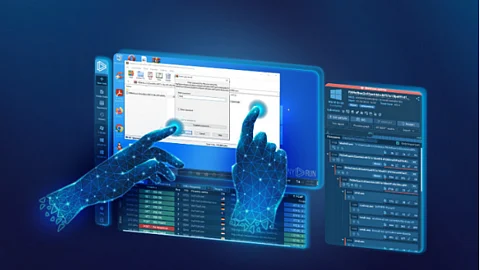

These days, cyber threats are becoming more frequent, and attackers are constantly changing their tactics, making it harder to detect malware.
As these threats grow in number and complexity, using the right tools and methods is more crucial than ever. One of the most effective tools for identifying and analyzing new threats is a malware sandbox.
A malware sandbox is a secure environment that allows you to analyze cyber threats within a virtual machine, without putting your systems at risk.
Simply put, it’s a place where you can upload a suspicious file or paste a link to see how it behaves in a controlled, safe space.
Some advanced malware sandboxes, like ANY.RUN, even let you interact with potential threats during the analysis. This means you can click buttons or explore suspicious links during the analysis session without worrying about any negative impact on your systems.
Create a free account on ANY.RUN to analyze malware securely
Malware sandboxes offer a range of benefits for cybersecurity analysts, as well as anyone concerned about their online safety. They provide a secure way to inspect potential threats without risking your system.
Here are just a few ways malware sandboxes can be used against possible cyber attacks:
Malware sandboxes are widely used to detect and analyze threats like malware and phishing attempts without worrying about potential attacks stealing sensitive data, causing financial loss, or executing other harmful actions on a victim's computer.
These tools are generally user-friendly and don’t require much effort. Simply upload the suspicious file or link and run an analysis session. Below is an example of a session run inside ANY.RUN’s sandbox.
The quickest way to identify a threat is by checking the top right corner of the analysis session. If you see a “malicious activity” label highlighted in red, it means that the uploaded file or link contains malware or a phishing attempt. In such cases, it’s best not to open it on your computer.
In this session, for example, a victim received an email from a "colleague." The content seemed suspicious, so they ran it through the malware sandbox. The analysis revealed that attackers had used the colleague’s name to send an email with a link, which leads to the download of a malicious file containing Agent Tesla malware.
When it comes to security, sandboxes are among the safest methods for checking suspicious activities. One of the key advantages of interactive sandboxes like ANY.RUN is that they allow you to perform the same actions you would on your computer, but in a secure environment.
Just like you would on your own device, you can interact with the sample inside the sandbox—click buttons, upload files, and explore the behavior of the potential threat. This lets you conduct thorough malware analysis without the risk of infecting your actual system.
One of the valuable features of a malware sandbox is its ability to monitor network traffic during analysis. Many types of malware try to connect to external servers to steal data or download more harmful software. A sandbox can track all this activity, showing you which websites or servers the malware is trying to reach.
This means you can see if a suspicious file is attempting to send out your sensitive info. It gives you a clearer picture of what the malware is trying to do, and it helps you block these risky connections before they can cause any damage.
A malware sandbox lets you dig into the details of what a suspicious file is actually doing. When you run a file in the sandbox, it shows you every action the file tries to take—like opening other files, changing system settings, or running hidden scripts.
This process breakdown helps you understand how the malware operates and what it’s trying to achieve.
For example, ANY.RUN features a process tree on the right side of the analysis session. This tree lays out all the processes and their subprocesses in a clear, hierarchical order, making it easy to trace each action the malware attempts.
After clicking on each process, you’ll see more detailed information about it.
With a malware sandbox, you can generate detailed reports on the activities of malware. These reports help you understand what the malware did during the analysis, making it easier to assess the threat.
In addition to these reports, a sandbox also gathers Indicators of Compromise (IOCs), such as IP addresses, domain names, file hashes, and more, which are crucial for identifying and blocking future threats.
For instance, in ANY.RUN's sandbox, all these IOCs are neatly organized in one place, making it easy to access and use them for strengthening your security measures, updating threat databases, or sharing with your cybersecurity team.
Using an interactive sandbox like ANY.RUN allows you to safely analyze malware in a secure environment. You can observe the behavior of suspicious files, track their actions, and gather valuable insights without risking your system. It’s a hands-on way to explore potential threats while keeping your network safe.
Create a free ANY.RUN account and start your first analysis today!
